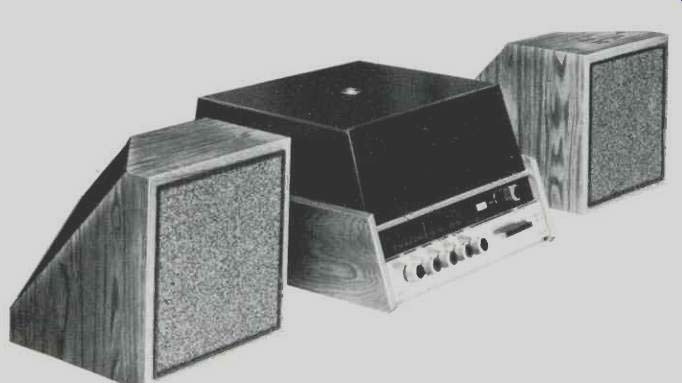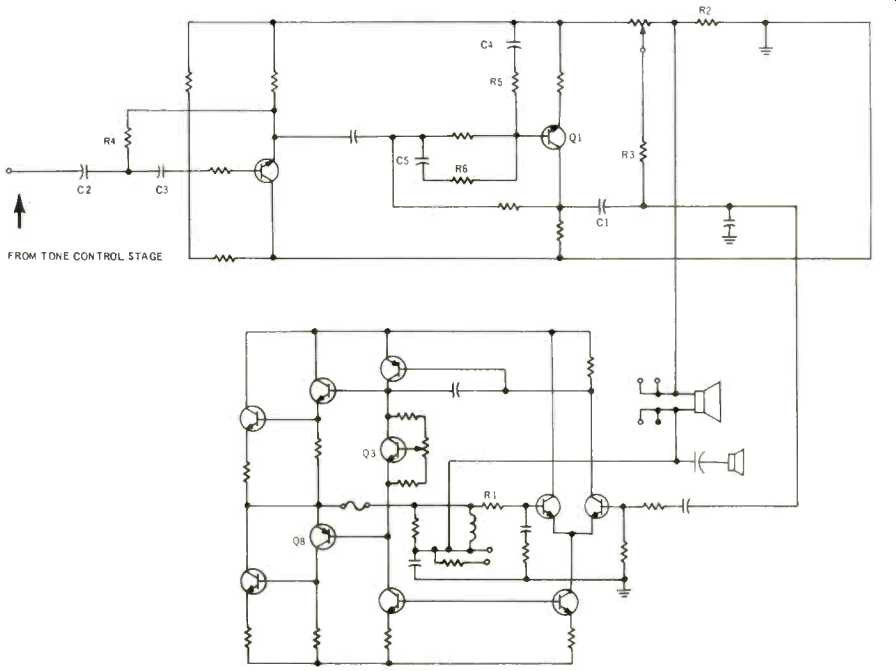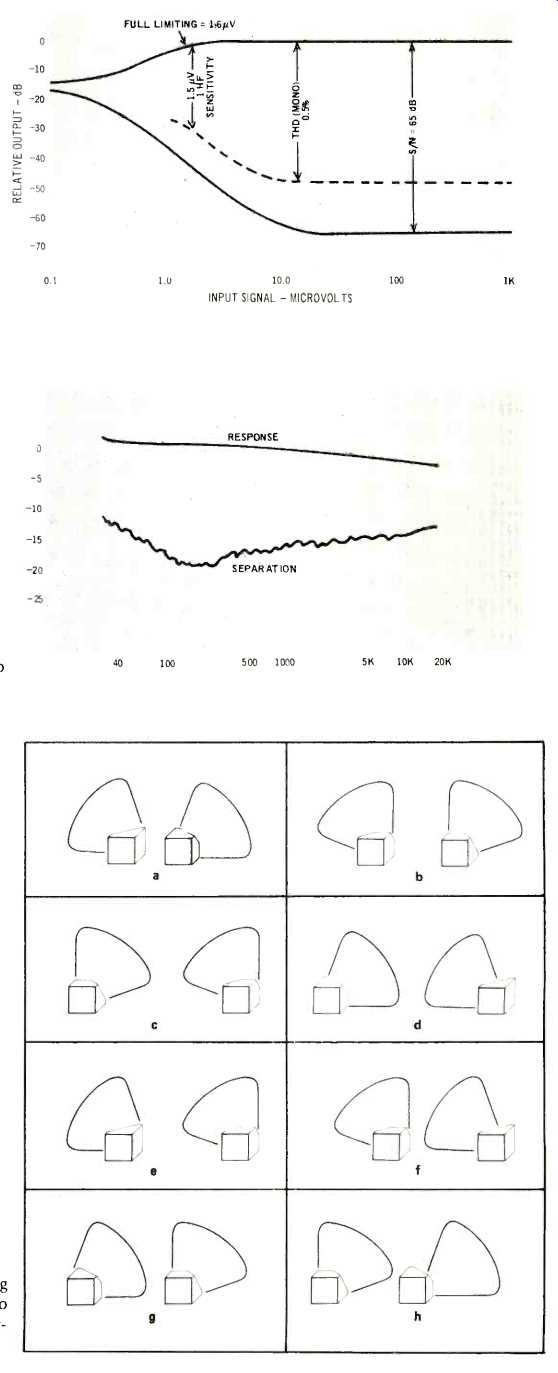
MANUFACTURER'S SPECIFICATIONS:
AMPLIFIER: Power Output: 40 watts continuous sine wave, both channels driven.
Harmonic Distortion: 0.15% at full output (1 kHz).
Power Bandwidth: 20-25,000 Hz.
Frequency Response: 20-25,000 Hz ±1.5 dB.
Hum and Noise:-70 dB (ref 100 mV to aux and tape inputs; phono:-55 dB (ref 3 mV input).
TUNER: Sensitivity: 1.9 µV IHF; Hum and Noise: -65 dB; Capture Ratio: 2.5 dB; Harmonic Distortion: 0.5% at full output (1 kHz); Separation: 30 dB at 1 kHz.
GENERAL: Changer: Garrard 3000; Speakers: Two, 10x10x10 in.
Dimensions, Electronics/Changer: 16 1/4" wide, 16 1/4" deep, 8 1/2" high.
Shipping Weight: 63 lbs. Price: $399.95.
Optional Dust Cover, $14.95.
I must admit that I do not take much more than a passing interest in compact systems these days but the EV Landmark had so many interesting features that I was impelled to take one home before I passed it to Mr. McProud for testing. I had heard one on a recent visit to the E-V plant, and I was most impressed.
The speakers are housed in small (10 inch) enclosures shaped like a cube with one corner sliced off. Each contains three full-range 4.5-inch speakers and a 2.5-inch tweeter. One large speaker is mounted at the front and the others are placed at asymmetric angles at the back.
Thus the cabinets-which are polished on all sides-can be placed in various positions to give different dispersion patterns--a very ingenious idea! System resonance is about 200 Hz and the amplifier response is `tailored' to produce a level acoustic response down to 60 Hz. Normally, this would give rise to a high distortion with such small speakers but this is reduced considerably by the use of a servo-feedback circuit shown in Fig. 1.
RI supplies d.c. feedback from the output to the pre-driver stage in the normal manner but the current from the loudspeaker voice coils flows through the one ohm resistor R2. The voltage developed across R2 reflects some of the irregularities and distortion inherent in the loudspeakers, and it is applied as negative feedback via R3 and C1 to the base of the amplifying transistor Ql. The net result is a lower distortion below 200 Hz where the loudspeakers are driven to a non-linear condition at high levels. As stated previously, the amplifier response is tailored to match the speaker system and this function is performed by R4, C2, and C3 (reducing response below 30 Hz ) R5 and C4 ( bass lift below 200 Hz) and R6 and C5 ( treble lift above about 5 kHz ).

Fig. 1--Servo-feedback and compensation circuits.
So much for the theory-but how does it perform? The answer is-very well indeed. Not as good as a high priced component system but certainly better than many of the cheaper ones. Bass is full with very little coloration and even an organ sounds quite impressive. High frequency dispersion was dependent on the positions of the speakers but in no case was it too directional and the response itself is free from irritating peaks and harshness. All-in-all, a very creditable achievement and Electro-Voice are to be congratulated.
(GWT) Over to Mr. Mc Proud.
The entire system consists of the electronics/changer package comprising the Garrard changer-equipped with a magnetic cartridge-in a neat cabinet, with the panel at the front mounting the dual controls for bass, treble, balance, and volume, and the input selector switch on the lower anodized aluminum portion. To their right are four push-push buttons for loudness, mono, tape monitor, and power. Still further to the right is the headphone jack. The upper half of the front accommodates the dial scale behind a very dark plastic window, the tuning meter, and the tuning knob. Aux and tape inputs plug into pairs of phono jacks on the back, with another pair for the tape output. The 15-foot speaker cables plug into 5-hole sockets on the back, and a pair of fuses in the speaker lines and the power-cord inlet are also on the rear panel.
The tuner section uses one FET and two bi-polar transistors in the front end, followed in turn by a µA703 IC i.f. amplifier, a ceramic filter, and a CA-3043 IC as a combination high-gain i.f. amplifier, limiter, FM detector, and audio preamp driver. The MPX circuitry is contained in one MC-1504 integrated circuit which controls the stereo indicator lamp and puts out the two stereo signals which pass through a pair of de-emphasis networks to the bases of the emitter-follower output stages of the tuner section.

Fig. 2-FM characteristics.
Fig. 3-Phono performance.
Fig. 4-Showing choice of stereo reflective patterns.
The AM section employs three transistors and one IC, and the built-in rod antenna will usually suffice for urban locations. The FM input is designed to accept a balanced 300-ohm line or an unbalanced 75-ohm line.
The preamp/tone control section performs all the usual functions of amplifying, equalizing, and controlling, and feeds out to the motional-feedback board, and thence to the power amplifier/power supply section.
Power output was measured at just under 40 watts (R.M.S.) with both channels driven-more than adequate for most requirements.
It is not often that such excellent specifications are offered for a "compact" system, nor is it often that speakers of such small dimensions are capable of providing an overall acoustic response to below 50 Hz and above 18,000. And even if the FM characteristics are claimed to be what these are, it is not usual to find that the performance meets the specifications. One does not normally expect to find the tuner in a compact system to have a sensitivity of 1.85 µV IHF. But then, the Landmark 100 is not a usual piece of equipment.
--C.G.McP.
(adapted from Audio magazine, Nov. 1970)
Also see:
Electro-Voice speakers (ad, Mar. 1973)
Electro-Voice Interface:A speaker sytem (Equip. Profile, Mar. 1976)
Eastman Sound Martin Crescendo 430 Speaker System (Oct. 1972)
Dynaco A-25XL Loudspeaker (Equip. Profile, Nov. 1976)
Dynaco AF-6 AM/FM Tuner (Equip. Profile, Sept. 1974)
Dynaco Stereo 70 Series II Tube Amp (Nov. 1992)
Electro-Voice microphones (Jan. 1973)
ESS Mk VII Speaker System (Jan. 1973)
= = = =